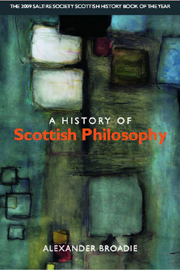Book contents
- Frontmatter
- Contents
- Acknowledgements
- 1 Introduction
- 2 John Duns Scotus
- 3 The Fifteenth Century
- 4 The Circle of John Mair
- 5 Humanism and After
- 6 Scotland Moves into the Age of Enlightenment
- 7 David Hume
- 8 Adam Smith
- 9 The Scottish School of Common Sense Philosophy
- 10 The Nineteenth Century: Ferrier to Seth
- 11 Realism and Idealism: Some Twentieth-century Narratives
- 12 Conclusion
- Bibliography
- Index
4 - The Circle of John Mair
Published online by Cambridge University Press: 12 September 2012
- Frontmatter
- Contents
- Acknowledgements
- 1 Introduction
- 2 John Duns Scotus
- 3 The Fifteenth Century
- 4 The Circle of John Mair
- 5 Humanism and After
- 6 Scotland Moves into the Age of Enlightenment
- 7 David Hume
- 8 Adam Smith
- 9 The Scottish School of Common Sense Philosophy
- 10 The Nineteenth Century: Ferrier to Seth
- 11 Realism and Idealism: Some Twentieth-century Narratives
- 12 Conclusion
- Bibliography
- Index
Summary
Section 1: John Mair and his circle
The late-fifteenth and early-sixteenth centuries were a period of transition for the European universities, as humanistic values encroached increasingly on late-medieval modes of thinking. Scottish philosophers participated in the various stages of the transition, and in this chapter I shall focus on aspects of their work. In the next chapter attention will be directed to the new scene that was opening up as the ‘modernisers’ started to dominate. John Mair (whose name appears in his lifetime, whether in print or in his own hand, as Mair, Maior and Major) is the dominant figure in the earlier part of the story. He was the centre of a circle at the University of Paris, a circle that included prominent Scottish and Spanish thinkers. Among the Scots were George Lokert, William Manderston and Robert Galbraith, all of whom returned to Scotland to take up major posts and thus in one form or another continued at home the work they had conducted abroad. Three other Scots who were in the circle of John Mair in Paris were David Cranston (c.1480–1512), Gilbert Crab (c.1482–1522) and William Cranston (c.1513–62). Of these only one, William Cranston, returned to Scotland, and I shall be writing about him in the next chapter since he is part of the new beginning that came with the encroachment of renaissance humanism into Scotland. David Cranston did not return to Scotland; he died in his early- to mid- thirties some weeks after receiving his doctorate in theology at Paris.
- Type
- Chapter
- Information
- A History of Scottish Philosophy , pp. 47 - 86Publisher: Edinburgh University PressPrint publication year: 2008



